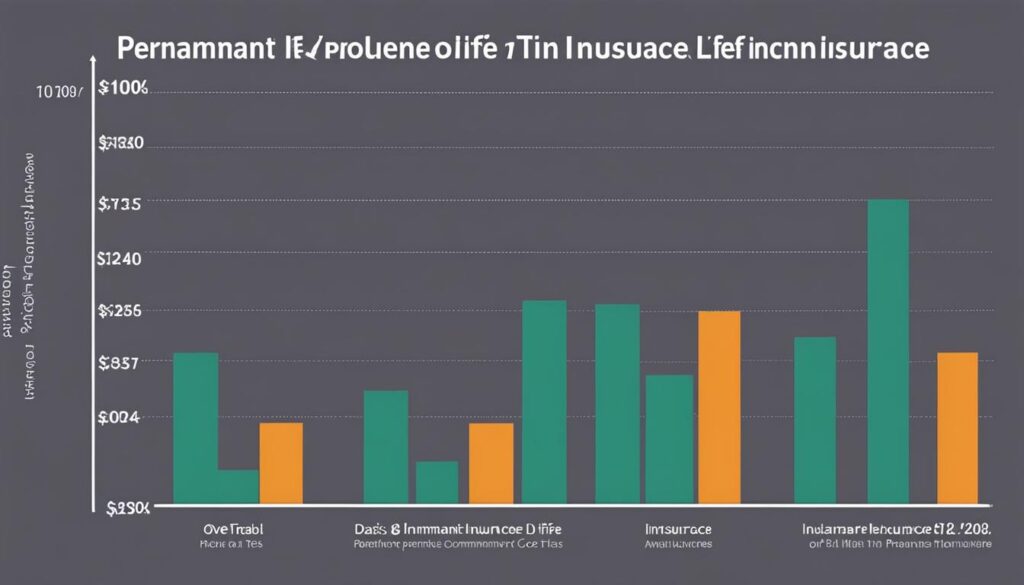Is Permanent Life Insurance Bad When it comes to life insurance, there are various options available, each with its own set of advantages and considerations. One common question that arises is whether permanent life insurance is a bad choice. The truth is, permanent life insurance is not inherently bad, but it may not be the best fit for everyone. Understanding the differences between permanent and term life insurance can help you make an informed decision.
Permanent life insurance, as the name suggests, is designed to provide coverage for the policyholder’s entire life. It offers lifelong protection and typically includes a cash value component that accumulates over time. On the other hand, term life insurance provides coverage for a specified period, often 10, 20, or 30 years, and does not accumulate cash value. Term life insurance policies are generally more affordable and straightforward, making them a popular choice for young and healthy individuals.
It’s important to assess your individual needs and financial goals before deciding on a life insurance policy. To help you understand the pros and cons of permanent life insurance and determine if it’s the right option for you, let’s compare it with term life insurance.
Key Takeaways:
- Permanent life insurance is not necessarily bad, but it may not be the best choice for everyone.
- Term life insurance is often more affordable and straightforward, making it suitable for young and healthy individuals.
- Understanding the differences between permanent and term life insurance can help you make an informed decision.
- Consider your individual needs and financial goals before choosing a life insurance policy.
- Consult with a trusted financial advisor to evaluate all available options and select the best policy for you.
Comparing Permanent and Term Life Insurance
When it comes to choosing a life insurance policy, two main options are term life insurance and permanent life insurance. Both types offer unique benefits and considerations that individuals should carefully weigh before making a decision. Let’s compare the key aspects of term and permanent life insurance to help you make an informed choice.
Differences Between Term Life Insurance and Permanent Life Insurance
Term life insurance provides coverage for a specific term, typically 10, 20, or 30 years. If the policyholder dies during the term, the insurance company pays the death benefit to the beneficiaries. However, if the policyholder outlives the term, the coverage expires, insurance is best and no death benefit is paid.
Also Read:- How Indexed Universal Life Insurance Policy Can Shape Your Financial Destiny
On the other hand, permanent life insurance is designed to last for the policyholder’s entire life, as long as the premiums are paid. It offers lifelong coverage and accumulates a cash value over time. The cash value component allows the policyholder to borrow against the policy or withdraw funds if needed.
Pros and Cons of Term and Permanent Life Insurance
| Term Life Insurance | Permanent Life Insurance |
|---|---|
|
|
Term life insurance is generally more affordable, making it an attractive option for individuals on a budget or looking for coverage during specific periods of their lives, such as when raising children or paying off a mortgage. It’s a straightforward policy with no accumulation of cash value, and the coverage expires at the end of the chosen term.
Permanent life insurance, on the other hand, offers lifelong coverage and the opportunity to build cash value over time. The cash value component can be accessed for loans or withdrawals, providing additional financial flexibility. However, permanent life insurance typically comes with higher premiums due to the extended coverage and life insurance is a type cash value feature.
Which Life Insurance Option is Right for You?
Choosing between term and permanent life insurance ultimately depends on your individual needs and financial goals. If you’re looking for temporary coverage at an affordable price, term life insurance may be the better choice. It’s ideal for individuals with specific financial responsibilities or a limited budget.
However, if you’re seeking lifelong coverage and the potential to build cash value, permanent life insurance might be the right option. It offers the advantage of coverage that lasts a lifetime and the ability to access funds if necessary. Keep in mind that permanent life insurance comes at a higher cost, so it’s essential to consider your long-term financial commitment and affordability.
Understanding the pros and cons of each type of life insurance can help you make an educated decision that aligns with your unique circumstances and goals. Consulting with a trusted financial advisor can also provide valuable insights and guidance in selecting the best life insurance policy for your needs.
Pros and Cons of Permanent Life Insurance
When considering life insurance options, it’s essential to weigh the pros and cons of permanent life insurance. This type of coverage offers certain advantages and drawbacks that individuals should carefully consider before making a decision.
Pros of Permanent Life Insurance
- Lifelong coverage: One of the significant benefits of permanent life insurance is that it provides coverage for the policyholder’s entire life. This ensures that beneficiaries receive a death benefit whenever the insured passes away, regardless of age or health condition.
- Cash value accumulation: Permanent life insurance policies have a cash value component that accumulates over time. This cash value grows on a tax-deferred basis, allowing policyholders to build a savings element within their insurance policy.
- Customization options: Permanent life insurance can be tailored to individual needs and preferences. It offers the flexibility to customize the policy with additional features or riders, such as accelerated death benefits or long-term care coverage.
- Tax benefits: The death benefit paid out to beneficiaries is typically tax-free. Additionally, the cash value growth is not subject to immediate taxation, providing potential tax advantages in the long run.
These benefits make permanent life insurance an attractive option for those seeking lifelong coverage and the potential to build a life insurance quotes financial asset over time.
Cons of Permanent Life Insurance
- Higher cost: One significant drawback of permanent life insurance is its higher cost compared to term life insurance. Premiums for permanent policies, especially whole life insurance, can be substantially more expensive. For example, a healthy individual may pay up to 20 times more for a whole life policy compared to a 20-year term policy with the same coverage amount.
- Complexity: Permanent life insurance is generally more complex than term insurance due to its cash value component. Policyholders need to understand how the policy works, including factors such as premiums, cash value growth, and potential policy loans or withdrawals.
These drawbacks highlight the importance of considering the financial implications and long-term commitment associated with permanent life insurance policies.
While permanent life insurance offers lifelong coverage and the potential for cash value accumulation, it may not be the most suitable choice for everyone due to its higher costs and complexity. It’s crucial to evaluate individual needs, financial goals, and budget constraints before deciding on the best life insurance option.
Benefits of Choosing Term Life Insurance
Term life insurance offers several advantages that make it a practical choice for many individuals. Here are some key benefits:
- Financial Protection During Critical Years: Term life insurance provides coverage for a specific period, typically when financial responsibilities are at their highest. For example, raising children or paying off a mortgage. This ensures that your loved ones are protected financially during these crucial years.
- Affordability: Term life insurance is generally more affordable compared to permanent life insurance policies. This makes it easier to budget for premiums, especially for individuals who may have other financial obligations.
- “Living Benefits” Option: While term life insurance policies do not have a cash value component like permanent life insurance, many term policies now offer “living benefits.” These benefits allow policyholders to access the death benefit if they become terminally or critically ill. Accessing the benefit during a difficult time can provide much-needed financial support.
It’s important to note that the goal of term life insurance is for the policy not to pay out, as it means the policyholder is alive and well. This makes term life insurance a cost-effective solution for those looking for financial protection during a specific period of time.
Overall, term life insurance offers practical coverage at an affordable price, ensuring that your loved ones are financially protected during crucial years. If you’re looking for a straightforward insurance option without the need for a cash value component, term life insurance may be the right choice for you.
Understanding Permanent Life Insurance Options
When considering permanent life insurance, it’s crucial to understand the different types available. Each type of permanent life insurance offers unique features and benefits, catering to specific financial goals and preferences.
Whole Life Insurance
Whole life insurance provides guaranteed coverage for the policyholder’s entire life. It offers a fixed cash value component that grows over time. This type of permanent life insurance offers stability and long-term financial protection.
Universal Life Insurance
Universal life insurance offers more flexibility compared to whole life insurance. It allows policyholders to adjust the death benefit and premium payments according to their changing needs. Universal life insurance policies also accumulate cash value that can be accessed or used as collateral for loans.
Variable Life Insurance
Variable life insurance combines life insurance coverage with investment opportunities. Policyholders can allocate the cash value of their policy to different sub-accounts, similar to mutual funds. This type of permanent life insurance offers potential for higher returns but also comes with investment risks.
Survivorship Life Insurance
Survivorship life insurance covers two or more individuals and pays out the death benefit when the last insured person passes away. It is commonly used for estate planning purposes and ensures that beneficiaries receive financial protection after both policyholders are no longer alive.
Each type of permanent life insurance has its own advantages and considerations. It’s important to evaluate individual financial goals, risk tolerance, and long-term plans before deciding on the most suitable permanent life insurance option.

| Type of Permanent Life Insurance | Features | Considerations |
|---|---|---|
| Whole Life Insurance | – Guaranteed coverage for life – Fixed cash value growth – Stable and predictable |
– Higher premiums – Limited flexibility compared to other options |
| Universal Life Insurance | – Flexible death benefit and premium payments – Access to cash value – Can be adjusted to changing needs |
– Requires active management – Cash value growth is not guaranteed |
| Variable Life Insurance | – Investment opportunities – Potential for higher returns – Cash value can be accessed |
– Investment risk – Requires active management – No guarantee for cash value growth |
| Survivorship Life Insurance | – Covers two or more individuals – Pays out after the last insured person passes away – Estate planning benefits |
– Premiums may be higher than individual policies – Requires careful consideration of beneficiaries |
Pros of Permanent Life Insurance
Permanent life insurance offers lifelong coverage to policyholders, ensuring that beneficiaries receive a death benefit no matter when the policyholder passes away. This provides peace of mind and financial security for loved ones, even in the event of untimely deaths.
Additionally, permanent life insurance policies accumulate a cash value over time. This means that as the policyholder pays premiums, a portion of the money goes toward building up the cash value within the policy. The policyholder can access this accumulated cash value through withdrawals or loans, providing a source of funds that can be used for various purposes, such as supplementing retirement income or meeting unexpected financial needs.
Another advantage of permanent life insurance is its flexibility. These policies can be customized with additional riders, which are add-ons that provide extra benefits and tailored coverage. Some common riders include disability income riders, which provide replacement income if the policyholder becomes disabled, and long-term care riders, which cover long-term care expenses.
Permanent life insurance also offers tax benefits. The death benefit is typically tax-free for beneficiaries, which means they receive the full amount without having to pay taxes on it. Additionally, the cash value within the policy grows on a tax-deferred basis, meaning the policyholder does not have to pay taxes on the accumulated cash value until it is withdrawn or borrowed against.

Cons of Permanent Life Insurance
While permanent life insurance has its benefits, there are several drawbacks that should be considered before making a decision.
1. More Expensive Than Term Life Insurance: One significant disadvantage of permanent life insurance is its higher cost compared to term life insurance. Premiums for permanent policies, especially whole life insurance, can be significantly more expensive. This can put strain on your budget and make it difficult to afford the coverage you need.
2. Complexity: Permanent life insurance policies can be complex due to their cash value component. Understanding how the cash value works, including growth rates and potential fees, requires careful consideration and may be confusing for some policyholders.
3. Potential Lapse of Coverage: If you are unable to keep up with the higher premiums of permanent life insurance, there is a risk that your policy may lapse. This means that you would lose your coverage and any accumulated cash value, leaving you without the protection that life insurance provides.
4. Expensive Way to Save for Retirement: While permanent life insurance policies offer a cash value that grows over time, they may not be the most cost-effective way to save for retirement. Other investment options like IRAs or 401(k)s may provide better returns and greater flexibility for retirement savings.
Before committing to a permanent life insurance policy, carefully weigh these drawbacks against the benefits to ensure that it aligns with your financial goals and circumstances.

Cost of Permanent Life Insurance
When considering life insurance options, it’s important to be aware of the cost associated with permanent life insurance. Compared to term life insurance, permanent life insurance generally comes with a higher price tag. On average, whole life insurance can cost up to 20 times more than a 20-year term policy.
The cost of permanent life insurance varies depending on several factors, including age, gender, health, and coverage amount. These variables can significantly impact the overall premium. For instance, a healthy individual in their 30s can expect to pay a more affordable rate compared to an older individual with pre-existing health conditions.
It’s crucial to carefully weigh the long-term financial commitment of permanent life insurance and its affordability before making a decision. Analyzing your budget and financial goals is essential to ensure that the cost of coverage aligns with your needs.
Permanent Life Insurance Cost Comparison
Let’s explore the cost difference between permanent and term life insurance using a comparison of average rates:
| Age | Gender | Coverage Amount | Term Length | Permanent Life Insurance (Average Annual Premium) | Term Life Insurance (Average Annual Premium) |
|---|---|---|---|---|---|
| 35 | Male | $500,000 | Whole Life | $6,790 | N/A |
| 35 | Male | $500,000 | 20-Year Term | N/A | $336 |
| 35 | Female | $500,000 | Whole Life | $5,918 | N/A |
| 35 | Female | $500,000 | 20-Year Term | N/A | $276 |
The table above illustrates the significant price disparity between whole life insurance and a 20-year term policy for a 35-year-old individual. While the whole life insurance premium can be quite substantial, term life insurance offers a more affordable option for comparable coverage.
It’s important to note that these premium rates are average estimates and can vary depending on individual circumstances. Consulting with a life insurance advisor or obtaining personalized quotes can provide a more accurate cost evaluation.
Considering the cost of permanent life insurance is a critical aspect of making an informed decision. Taking your financial situation, goals, and budget into account will help determine if permanent life insurance is the right choice for you.

Determining If Permanent Life Insurance is Right for You
Whether permanent life insurance is the right choice depends on your individual circumstances and financial goals. It’s important to evaluate your personal needs, budget, and long-term financial objectives before deciding if permanent life insurance is the right fit for you.
Permanent life insurance may be particularly suitable if you have lifelong dependents who rely on your financial support, such as a disabled child or a spouse with limited earning capacity. With permanent coverage, you can ensure that your loved ones are protected and have the financial resources they need, no matter when you pass away.
Another factor to consider is your desire to leave a financial legacy for your heirs. Permanent life insurance provides a death benefit that can contribute to your beneficiaries’ financial security after you’re gone. This can be especially beneficial if you have significant assets or estate planning considerations.
Additionally, the desire for a cash value component may play a role in your decision-making process. Permanent life insurance policies accumulate a cash value over time, which can be accessed through withdrawals or loans. This feature can provide flexibility and financial options should the need arise.
However, it’s crucial to weigh the pros and cons and consider alternatives. Permanent life insurance typically comes at a higher cost compared to term life insurance, so affordability is a key factor to assess. You should also evaluate your long-term financial goals and whether other investment options may better suit your needs.
Ultimately, determining if permanent life insurance is right for you requires careful consideration of your individual circumstances, financial situation, and objectives. Consulting with a trusted financial advisor can provide additional guidance and help you make an informed decision.

| Pros | Cons |
|---|---|
|
|
Conclusion
After weighing the pros and cons, it is clear that permanent life insurance is not inherently bad but may not be the best fit for everyone. Term life insurance often offers a more practical and affordable solution, particularly for young and healthy individuals. However, for those with specific financial needs or a desire for lifelong coverage, permanent life insurance can be a viable option.
It is crucial to carefully review individual circumstances, evaluate all available life insurance options, and consult with a trusted financial advisor before making a decision. By considering factors such as budget, long-term financial goals, and the need for a cash value component, individuals can determine whether permanent life insurance is worth it.
While permanent life insurance offers benefits such as lifelong coverage and the accumulation of cash value, it also has drawbacks. The higher cost compared to term life insurance and the complexity of policies due to the cash value component are important considerations. Reading permanent life insurance reviews can provide additional insights and help in making an informed decision.
In conclusion, when considering life insurance options, it is essential to weigh the advantages and disadvantages of permanent life insurance. While term life insurance may be the more practical choice for many individuals, permanent life insurance can be a valuable option for those with specific financial needs or a desire for lifelong coverage. By conducting thorough research, individuals can make an informed decision that suits their unique circumstances and preferences.
FAQs
Q: Is permanent life insurance a good choice for me?
A: Whether permanent life insurance is a good choice for you depends on your individual financial situation and long-term goals. It offers lifelong coverage and has a cash value component, but it tends to be more expensive than term life insurance. Consulting with a financial advisor can help you determine if permanent life insurance aligns with your needs.
Q: What are the differences between term and permanent life insurance policies?
A: Term life insurance provides coverage for a specific period, such as 10, 20, or 30 years, while permanent life insurance offers coverage for the policyholder’s entire life. Additionally, permanent life insurance accumulates cash value over time, which can be used while the insured is still alive.
Q: How do I decide if I need permanent life insurance?
A: Determining if you need permanent life insurance involves evaluating your long-term financial obligations and whether you have dependents who will need financial protection after your passing. Factors such as estate planning, final expenses, and providing for a special needs child or financially dependent family member may indicate a need for permanent life insurance.
Q: What are the advantages of permanent life insurance?
A: Permanent life insurance offers lifelong coverage, builds cash value over time, and provides a tax-advantaged investment component. It can also be used for estate planning purposes and to leave a financial legacy for beneficiaries.
Q: Are there any disadvantages to purchasing permanent life insurance?
A: While permanent life insurance provides lifelong coverage and a cash value component, it tends to be more expensive than term life insurance. Additionally, the investment portion may not offer the same growth potential as other investment options.
Q: What types of permanent life insurance policies are available?
A: Permanent life insurance policies include whole life insurance, universal life insurance, and variable universal life insurance. Each type has unique features and benefits, so it’s essential to understand the differences before choosing a policy.
Q: Can I switch from a term life insurance policy to a permanent life insurance policy?
A: Many insurance companies offer the option to convert a term life insurance policy into a permanent life insurance policy without the need for a medical exam. However, it’s important to consider the potential increase in premiums when making this decision.
Q: How can I determine the amount of permanent life insurance coverage I need?
A: Calculating the appropriate amount of permanent life insurance coverage involves assessing your long-term financial obligations, including future expenses, income replacement for family members, and potential estate taxes. Consulting with a financial advisor can help ensure you have adequate coverage.
Q: Are there alternatives to permanent life insurance?
A: Alternatives to permanent life insurance include term life insurance, final expense insurance, and investments in other tax-advantaged vehicles such as retirement accounts or annuities. These alternatives should be considered based on individual financial goals and needs.
Q: How do I choose the best permanent life insurance policy?
A: Choosing the best permanent life insurance policy involves comparing quotes from various life insurance companies, understanding the features and benefits of different types of permanent insurance, and considering your long-term financial goals. It’s also beneficial to seek guidance from a qualified insurance agent or financial advisor.




